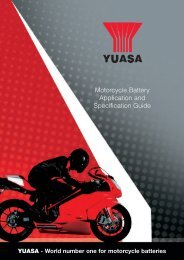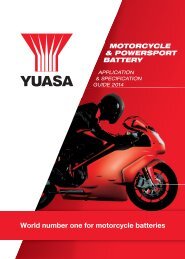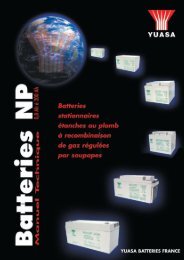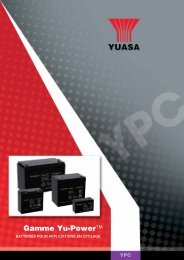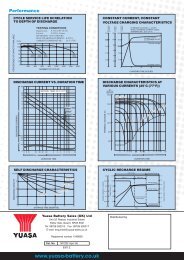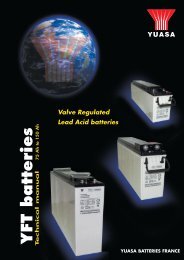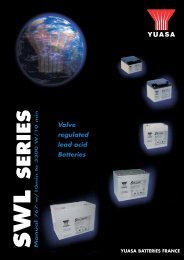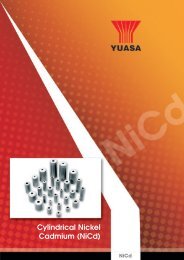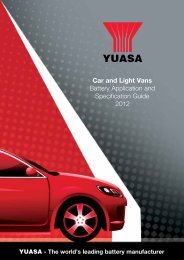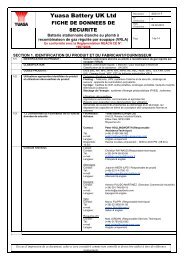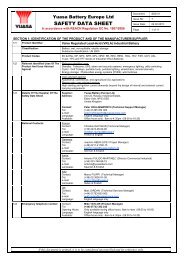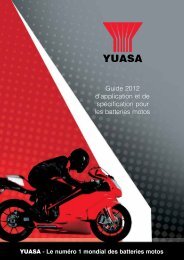YUASA - The world's leading battery manufacturer
YUASA - The world's leading battery manufacturer
YUASA - The world's leading battery manufacturer
You also want an ePaper? Increase the reach of your titles
YUMPU automatically turns print PDFs into web optimized ePapers that Google loves.
Battery Testing continued<br />
• <strong>The</strong> <strong>battery</strong> has lost performance due to external factors,<br />
such as overcharging, undercharging, deep cycling, wear<br />
and tear<br />
<strong>The</strong>se are not manufacturing defects.<br />
REPLACE BATTERY/CELL SHORT CIRCUIT<br />
• Accept Claim<br />
• Battery is defective, replace <strong>battery</strong> under terms and<br />
conditions of warranty<br />
• Note, if repeated claim from one fleet user, further<br />
investigation of <strong>battery</strong> usage required especially if the<br />
<strong>battery</strong> is overdischarging and overcharging<br />
TEST NOT POSSIBLE/CHECK CONNECTION<br />
• Check tester leads (another <strong>battery</strong>) and ensure terminals<br />
are clean<br />
• Switch off all electrical consumers when testing the <strong>battery</strong> if<br />
still fitted to the vehicle<br />
• Check Battery Voltage with multimeter, if Voltage > 0 Volts.<br />
Disconnect Battery from vehicle then recharge/retest<br />
NO DISPLAY<br />
• Confirm Battery Voltage = 0 Volts with multimeter<br />
• Accept Claim<br />
B2. SPECIFIC ACID GRAVITY TESTING –<br />
Battery with removable vent plugs<br />
In a good <strong>battery</strong> the specific acid gravity (sg) should be the<br />
same in all cells. <strong>The</strong> expected tolerance between all 6 cells is<br />
0.03g/cc (e.g. range of 1.26g/cc to 1.29g/cc).<br />
• After charging a flat <strong>battery</strong>, insufficient charging may lead to<br />
insufficient mixing of acid above the plates. Using a<br />
multimeter, confirm the stabilised measured voltage<br />
matches the voltage calculated from the specific acid gravity<br />
measurement<br />
• (Average measured specific acid gravity +0.84) x 6 should<br />
be equal to the measured voltage using a digital multimeter.<br />
If not, continue to recharge the <strong>battery</strong><br />
Acid Gravity 15°C 1.25-1.28 g/cc Battery Condition Fully<br />
Charged - Proceed with Test<br />
Acid Gravity 15°C 1.20-1.25g/cc Battery partially charged –<br />
Charge before proceeding<br />
Acid Gravity 15°C less than 1.20g/cc Battery low state of<br />
charge – charge immediately, the <strong>battery</strong> may or may not<br />
recover, subject to period <strong>battery</strong> left in this low state of charge<br />
B2.1 Has one cell a lower acid gravity than others?<br />
• Example 1.26, 1.25, 1.25, 1.26, 1.26, 1.15<br />
• YES – Accept Claim<br />
• Replace Battery under terms and conditions of warranty<br />
• NO<br />
• Continue to B2.2<br />
B2.2 Is the electrolyte dark brown and/or evidence of<br />
excessive water consumption/topping up?<br />
• YES – Reject Claim<br />
• Damaged caused by overcharging<br />
This is not a manufacturing fault. Check voltage<br />
regulator on vehicle.<br />
• NO<br />
• Continue to B2.3<br />
B2.3 If the specific acid gravity is the same in all cells but<br />
reading lower than 1.25g/cc, charge the <strong>battery</strong>.<br />
• Is the <strong>battery</strong> charge acceptance able to achieve the<br />
recommended recharge current, (see catalogue) after 1-2<br />
hours after commencing charging?<br />
• NO – Reject Claim<br />
• Battery badly sulphated due to deep discharging or<br />
undercharging<br />
This is not a manufacturing fault. Check the vehicle<br />
charging system (fan belt tension, alternator<br />
regulator).<br />
• YES<br />
• Complete the recommended recharge<br />
• Continue to B2.4<br />
B2.4 Is the specific acid gravity the same in all cells and above<br />
1.25g/cc?<br />
• NO<br />
• All cells even but less than 1.24g/cc, then extend<br />
recharge by 6 hours<br />
• If one cell has a lower specific acid gravity than others<br />
go back to B2.1<br />
• YES<br />
• Continue to C High Rate Discharge Testing<br />
C HIGH RATE DISCHARGE TESTING<br />
This test should only be carried out if <strong>battery</strong> voltage > 12.5V,<br />
otherwise recharge <strong>battery</strong> according to recommended<br />
recharge rates and period (see catalogue)<br />
C1.0 Is the High Rate Discharge Test indicating GOOD Battery?<br />
• YES<br />
• Reject Claim<br />
• NO<br />
• Continue to C2.0<br />
C2.0 Was end of Discharge test showing immediate drop to 0<br />
Volts?<br />
• YES<br />
• Accept Claim (subject to no visual damage to <strong>battery</strong>)<br />
Manufacturing Defect – Internal Connection break.<br />
Replace <strong>battery</strong> under terms and conditions of<br />
warranty.<br />
• NO – End of test showed 1.0 Volts to 9.0 Volts<br />
• Reject Claim<br />
This is not a manufacturing defect. Service<br />
deterioration.<br />
Battery Testing<br />
WHEN TO USE A DIGITAL TESTER Voltage CCA vs. Fault and<br />
Check Rating Condition<br />
NEW BATTERY EVALUATION (Before installation) YES NO* YES<br />
WARRANTY CLAIM TEST (After installation) YES YES YES<br />
BATTERY HEALTH CHECK (After installation) YES YES YES<br />
* See Digital Conductance Testers explained<br />
Note: If the <strong>battery</strong> has been identified as over<br />
discharged, then attempt to recharge, however if<br />
the <strong>battery</strong> has been left in low state of charge for<br />
period of time, recovery is less likely due to the<br />
deposition of large crystal sulphate formation in<br />
the plates and in the separators which will lead to<br />
grid damage and soft short circuits in the<br />
separator during attempts to recharge.<br />
<strong>YUASA</strong> - <strong>The</strong> <strong>world's</strong> <strong>leading</strong> <strong>battery</strong> <strong>manufacturer</strong><br />
175




